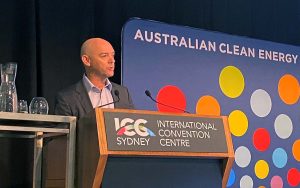Op-ed: How ultra low-cost solar will unlock Australia’s superpower vision
A new ARENA white paper, The Incredible Potential of Ultra Low-Cost Solar in Australia, highlights huge opportunities if we can boost solar efficiency and cut costs. ARENA CEO Darren Miller explains why urgent action is needed.

Darren Miller is CEO of the Australian Renewable Energy Agency (ARENA)
Forty years ago, Australian scientists invented the modern-day solar cell and kickstarted a global solar PV industry. So successful has solar become that the International Energy Agency has declared it as the cheapest form of energy generation the world has ever seen.
Current solar and wind technology is already mature enough to transform our electricity system, support the growth of electric vehicles and make the switch to all-electric homes and businesses. This is a worthy and important task. As such, it has considerable grassroots support and increasing investment from all levels of government.
However, it is clear the impressive renewable energy technologies currently at our disposal are not able to be produced and installed in the enormous volumes and at a sufficiently low cost to outcompete fossil fuels for many important end uses such as heavy industry, hydrogen production and long-distance transport.
Australia’s key assets include our vast land mass, low population density, and an abundance of sunshine. All of this points to ultra low-cost solar as the hero in our superpower vision.
What is ultra low-cost solar?
ARENA recently published a white paper, The Incredible ULCS: How Ultra Low-Cost Solar Can Unlock Australia’s Renewable Energy Superpower.
Ultra low-cost solar will more efficiently convert sunlight to energy. It will be manufactured from affordable, abundant, safe and stable materials. And finally, it will be deployed in the field at low cost and in a highly efficient, automated way.
Once operational ultra low-cost solar will require little ongoing maintenance and have a longer lifetime than today’s solar technology. Its low risk will attract financial backing from private investors and our financial institutions
Unless we make ultra low-cost solar a reality in Australia, we may never unlock our renewable superpower potential. We will limit the Australian economy’s options to adapt and thrive in the 21st century.
In the decades ahead, as the world decarbonises, our trading partners will seek low emissions sources of metals, chemicals and other materials that will be the backbone of the net zero global economy. Highly energy intensive commodities like lithium, steel and ammonia will need power from cheap renewable energy or low carbon sources.
Ultra low-cost solar will fill that gap.
There is no question that cheap solar alone is not the whole answer. We also need other components such as cheap wind energy, low-cost firming, transmission and demand-side flexibility.
However, without cheap solar, the transition to net zero will be more expensive and carry significant risks to Australia’s resource dependent economy.
How will we realise ultra low-cost solar?

We can make ultra low-cost solar a reality by focusing on three crucial endeavours.
Firstly, our scientists and researchers must keep innovating and improving solar cells and module design. We must find new materials and technology to turn more of the sunlight that hits the solar panel into electricity.
Current modules for rooftop and large-scale deployment convert about 22% of the available energy into electricity. We need to push this beyond 30%.
Secondly, our engineers and entrepreneurs need to find lower cost ways to install solar. Current methods would require hundreds of workers connecting solar modules to mounting systems by hand in far-flung locations across Australia.
If it sounds expensive, that’s because it is.
We must move into the digital age with factories pre-assembling modules and GPS-guided robots installing them in the field.
Thirdly, we must work with Australian communities, First Nations people and landowners to make available the amount of land required to host these facilities and the new high-capacity transmission lines we’ll need to connect these solar farms to the end users.
In addition, we need to take a serious look at opportunities to manufacture more of the components needed.
Currently, China dominates the global supply chain for solar. We must increase our resilience to future supply chain shocks by building local capabilities.
What is Solar 30 30 30?
Having led the way with the first competitive auctions for solar farms back in 2016, which kickstarted our large-scale solar industry, ARENA has set an ambitious ultra low-cost solar goal we call Solar 30 30 30. We want to achieve solar module efficiency of 30 per cent and an installed cost for solar farms of 30 cents per watt by 2030.
This goal is within reach if governments, private investors and society as a whole commit to solving this particular challenge.
With the right focus we can leverage Australia’s comparative advantages to achieve our ultra low-cost solar vision without sacrificing today’s urgent decarbonisation challenges.
Now is the time to invest in the technologies we need for future economic success in a net zero world.
LIKE THIS STORY? SIGN UP TO OUR NEWSLETTER

ARENA